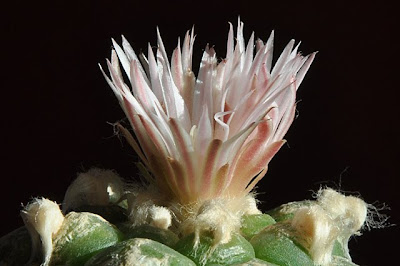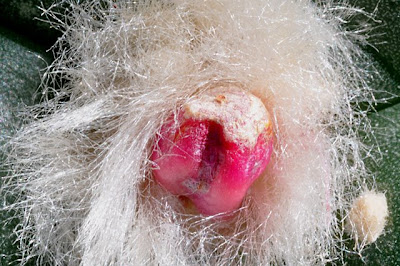
Flowering Lophophora koehresii
My grafted Lophophora koehresii (RS 1182; El Sabino, San Luis Potosí) just flowered for the first time this growing season.
The light pink flower with unusually thin petals having a darker midstripe is true to the species. What appears to be a “double-flowered” variety with extra petals in the picture above is in reality just three flowers unfolding at the same time.

Lophophora koehresii flowers, top view
The Lophophora koehresii scion was badly disfigured by spider mites but managed to outgrow some of the scarring after I started showering my plants regularly and treating them with neem oil – a treatment I intend to continue this year as it seems to be an effective means of controlling the spider mites (and with a bit of luck the plant will outgrow its defacing completely in a couple of years).

Lophophora koehresii disfigured by spider mites
The Trichocereus pachanoi stock plant hosts two different Lophophora koehresii clones (RS 1182; El Sabino, San Luis Potosí), both started from seed March 3, 2007. The first scion was grafted June 7, 2007 and when the Trichocereus pachanoi stock plant grew an offset I grafted another seedling on it May 5, 2008 (the second scion is visible in the foreground of the above picture). I intend to get seeds off this self-sterile species and just need to wait for the second Lophophora koehresii clone to flower before this “all inclusive” graft starts to produce seed ;-)
Saturday, April 24, 2010
Flowering Lophophora koehresii, spring 2010
Tuesday, November 03, 2009
Lophophora williamsii v. caespitosa graft – 5th anniversary
I'm sad to say that I have neglected this plant in more than one respect. First I forgot to post on its 5th “grafting anniversary” (this post is almost 5 months due), secondly I didn't check up on it all summer even though it had recently been under attack by red spider mites.

Lophophora williamsii v. caespitosa grafted on Trichocereus stock
As is evident from the pictures I didn't manage to get the mites fully under control before leaving the plant unattended for most of the hot summer months, during which the mites prospered and had a feast on the poor cactus.

Severe spider mite damage
I'm controlling the mites using neem oil, soap, and regular showers – I have considered miticides but am convinced that Darwinistic selection forces will kick in, leaving me with a population of miticide resistant spider mites in the windowsill ;-) I read somewhere that sulfur mixed in with the topsoil repels mites so I might try that (the less aesthetically pleasing solution is to dust the plants with sulfur). Hydrogen peroxide is also said to kill off mites so I still have a couple of options to try out before opting for the harsher chemicals.

Relatively undamaged button
Large areas of the grafted Lophophora williamsii v. caespitosa are still relatively unaffected by the mites so I'm sure it will grow back given time. I'm a bit puzzled, though, why this particular plant is so popular with the mites compared to most other plants in my collection.

Top view of grafted Lophophora williamsii v. caespitosa
For comparison you can check the posts on the same plant one, two, three, and four years ago.
Tuesday, April 21, 2009
The power of grafting – 5th anniversary
Five years ago today, I grafted a tiny Lophophora williamsii (SB 854; Starr Co, Tx) seedling onto a robust Trichocereus pachanoi stock. The Lophophora scion has since grown considerably – the main head is approximately 8 cm (~3.2'') wide; the total width including the offshoots now exceeds 14 cm (~5.5'').

Lophophora williamsii grafted onto Trichocereus pachanoi stock
This growing season the plant hasn't flowered yet but one of the “pups” (new offshoot stems) will do so within days as is evident from the next picture.

Flower bud and red spider mites
Unfortunately not only the plants are returning to life after their winter hibernation – the dreaded red spider mites are also fully active again (you should be able to spot at least four mites in the photo above) so the fight is on once more.

Ripe Lophophora williamsii fruit
Even though most of last year's fruits have long since ripened (and been harvested) the odd fruit is still showing. A plant this size gives hundreds of seeds each year making it a virtual seed “factory”.

Lophophora williamsii - rib count increasing?
The plant seems set on increasing its rib count beyond 8 – if I'm lucky it will not be content with growing just a few more ribs but go straight for the next number in the Fibonacci sequence, 13. The more ribs the merrier as it means more areoles and consequently more flowers and seeds.
The main head of the grafted Lophophora williamsii has grown 14 pups (15 if you also count a pup's pup – I guess you could call that a grandpup ;-) and has reached a size where it needs to be repotted soon.
For comparison you can check the posts on the same graft as one, two, three, and four years old.
Sunday, June 15, 2008
Lophophora williamsii v. caespitosa graft – 4th anniversary
June 7 my grafted Lophophora williamsii v. caespitosa plant could celebrate its 4th anniversary on top of its Trichocereus bridgesii stock. After four years the main head has grown to a width of 6 cm (~2.4'') and the scion is more than 14 cm (>5.5'') wide in total.

Lophophora williamsii v. caespitosa grafted on Trichocereus stock
Unfortunately the plant was maimed by spider mites last year. I didn't check my plants for mites before leaving them unattended for several weeks during my summer holiday. When I returned the damage was done and much of the plant ended up severely scarred.

Spider mite damage with new growth
Fortunately the spider mites stayed off most of my other plants, and the scarred epidermis of the grafted Lophophora williamsii v. caespitosa will soon be replaced by new growth.
To avoid spider mites I'm now showering my plants as often as the weather and my patience permit ;-) Any remaining mites are sprayed with isopropyl alcohol on sight. So far this treatment has kept my plants safe from mites, but the big test will be the coming hot summer months where the plants are left on their own to a great extent.

Lophophora caespitosa scarred by spider mites
As always I’m fascinated with the explosive growth induced by the Trichocereus stock – for comparison you can check the posts on the same plant one, two, and three years ago.
Friday, February 18, 2005
Return of the red bastards
I recently lost all of last years Lophophora fricii seedlings (and a lot of the L. diffusa and L. williamsii seedlings as well) because of too prudent a watering scheme – or so I presumed.
To my dismay the withering of the surviving seedlings continued, even after generous waterings. After a closer inspection of the seedlings, using a x10 magnifying lens, the reason became clear: a bunch of red spider mites were feasting on the plants.
The plants were promptly sprayed with insect soap and the treatment will be repeated in a week. It probably won’t kill off all of the spider mites, so the battle is now on. Last year I fought the spider mites using soap, predator mites, cinnamon and garlic brews, and by raising the humidity levels and increasing the air circulation – apparently some survived.
I wonder if I would have been able to save my L. fricii plants if the mites had been discovered sooner.
All Time Most Popular Posts
-
Lophophora williamsii (peyote) populations have diminished in large areas of South Texas where peyoteros harvest the cactus for ceremonial ...
-
On various occasions I've been asked what growing media I'm using for my cactus plants. I don't have a set soil mix recipe as su...
-
Below is a list of retailers/nurseries selling cactus seed and plants. I've only listed vendors I've done business with. If you ar...
-
Most cacti are easily grown from seed - and with a little patience and care they can be grown into beautiful plants. Lophophora williamsi...
-
In last month’s post on the troubled Texan peyoteros I referred to Anderson’s article on the peyote situation in Texas. Given the importanc...
-
Yet another slightly off topic and probably not entirely politically correct post, but I couldn’t help noticing the similarity of my monstr...
-
Flowering stand of San Pedro cacti (Trichocereus pachanoi) To me the main draw of the San Pedro cactus ( Trichocereus pachanoi (syn. Ech...
-
In the June 2008 issue of the Cactus & Co magazine Jaroslav Šnicer, Jaroslav Bohata, and Vojtěch Myšák described a new Lophophora spec...
-
There seems to be an increased focus on the alarming Texas peyote situation. A couple of weeks ago the Houston Press published a mournful, i...
-
I spent two weeks working in Delhi, India during January. I had one weekend off and had planned to spend it in Delhi at my own leisure, but ...


















